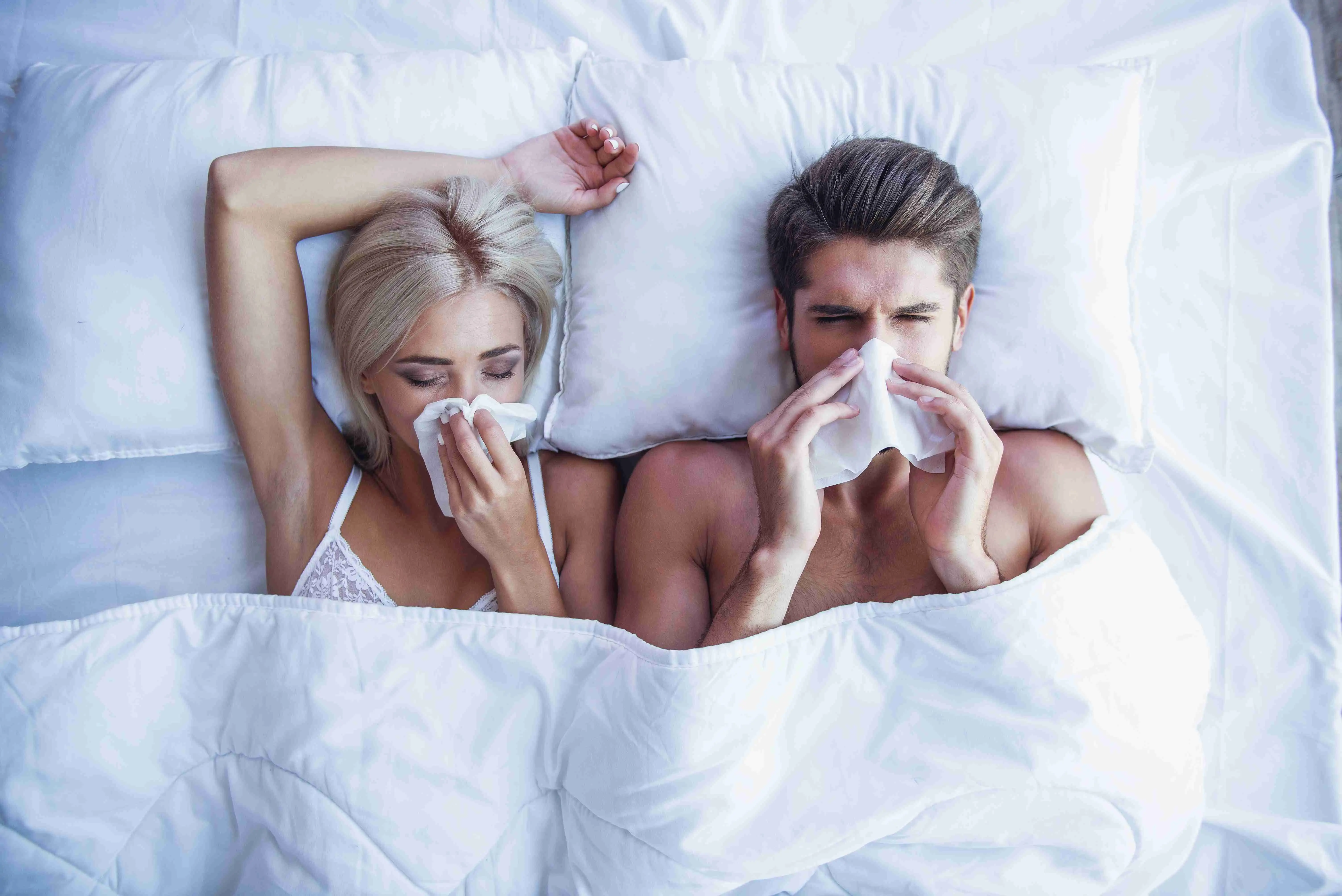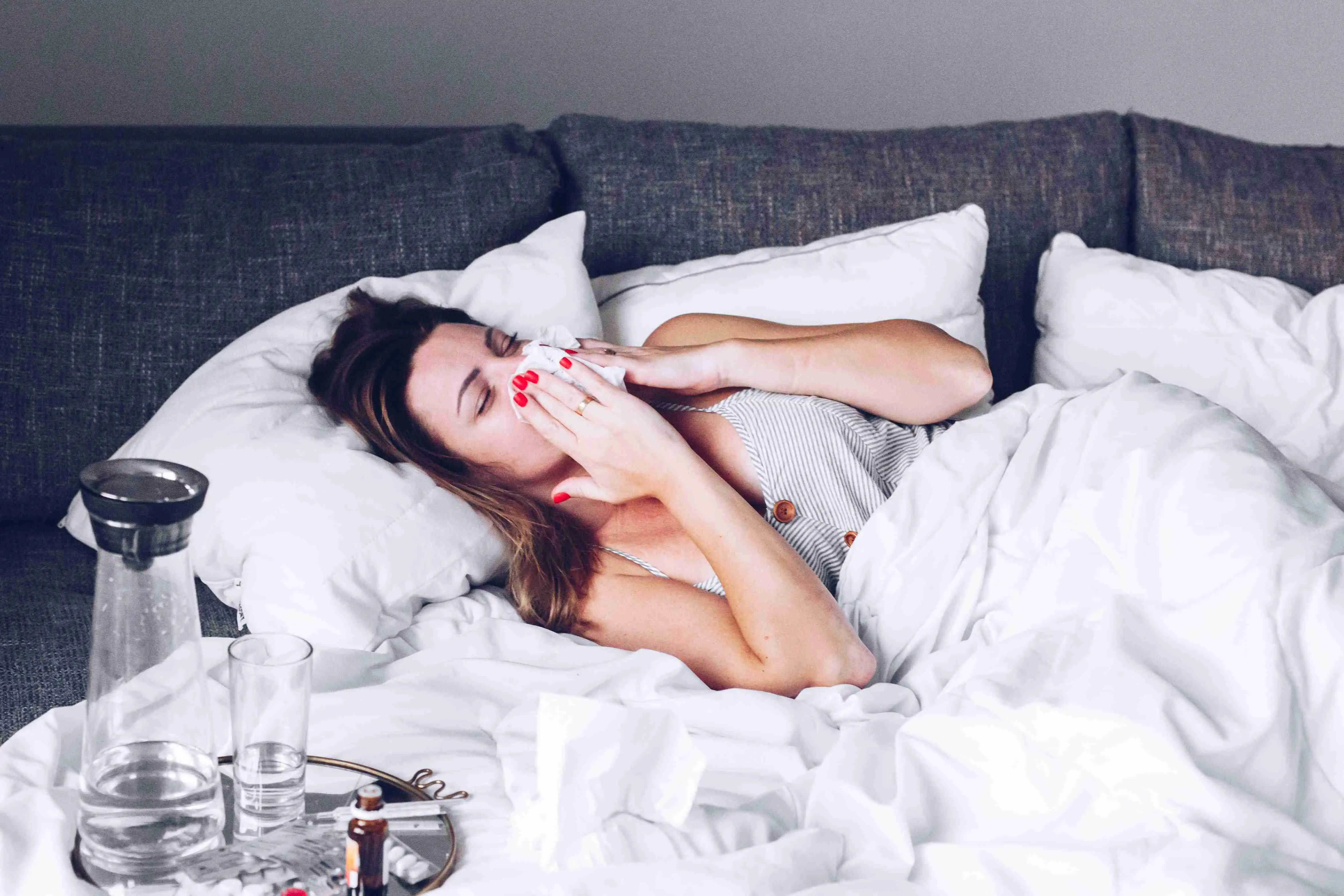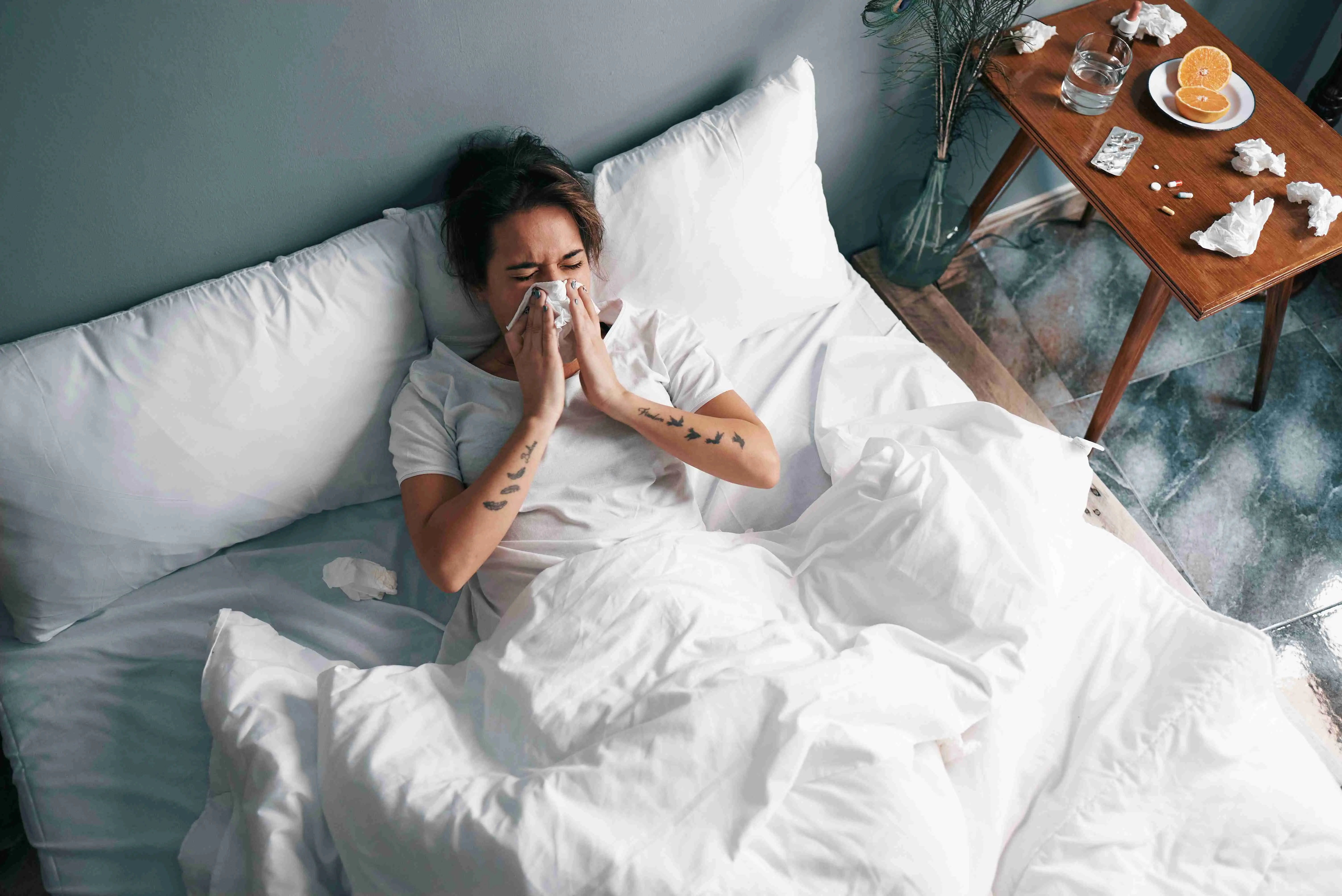Bedding allergies are reactions to irritants caused by certain microscopic organisms living in your bedding. These allergies constitute a real problem as they can aggravate symptoms in asthma patients and make it more difficult to breathe. Bedding allergies are characterized by sneezing, running nose, itchy, red, or watery eyes, and many other symptoms.
Along with the discomfort from allergic reactions, people who suffer from bedding allergies have a difficult time sleeping and may wake up many times at night, reducing sleep quality.
In this post, we will explore everything you should know about bedding allergies.
Key Takeaways
- Bedding allergies are immune responses triggered by dust mites, mold, or pet dander in bedding. Symptoms include sneezing, itchy eyes, skin irritation, and difficulty breathing.
- Dust mites thrive in warm, humid bedding environments, feeding on dead skin cells. Mold grows in damp areas, including mattresses. Pet dander lingers in bedding and furniture. Factors like high humidity, poor hygiene, and loosely woven fabrics increase risk of bedding allergies.
- Use hypoallergenic bedding materials like silk or bamboo, wash bedding weekly, reduce room humidity, and clean regularly. Keep pets off beds to minimize exposure to dander.
- You can treat and manage bedding allergies through short-term remedies like antihistamines and decongestants or long-term options like immunotherapy. Lifestyle changes also help manage symptoms effectively.
What Are Bedding Allergies?

Bedding allergies are the immune system's reaction to irritants left behind by microorganisms and other allergens found in bedding. These allergies happen when you come in contact with dust mites, pet dander, or mold.
What Causes Bedding Allergies?
- Dust mites are a common cause of bedding allergies. They thrive in warm and humid environments like mattresses, pillows, and carpets. Because they are microscopic creatures, you can't see them or clean them out using conventional methods. Beddings are a hotspot for dust mites because they're suckers for dead skin cells and feed off them.
- Mold is another type of allergen caused by a fungus that releases spores into the atmosphere and is commonly found on damp materials. Mold thrives best in the bathrooms, but if your room is damp enough, you might find mold growing on your mattress and clothes.
- Pet dander comes from the skin cells of furry animals such as cats, dogs, birds, rabbits, and guinea pigs. Because it is microscopic and can stick to furniture, bedding, and fabric, pet dander tends to linger in the air for a longer period.
Common Symptoms of Bedding Allergies

You can tell you have bedding allergies by typical symptoms like itchy eyes, runny nose, skin irritation, and sneezing. More severe symptoms can include difficulty breathing accompanied by wheezing or whistling sounds and chest tightening.
You may confuse a bedding allergy with an upper respiratory viral illness like influenza and the common cold. If you are not sure your allergies are from your bedding, you should reach out to a healthcare professional. However, you can tell your allergies come from your bedding when you observe you have a flareup of these symptoms when you lie on the bed. Extreme cases can include an eczema flareup or a consistency in these symptoms, even when it is not flu season.
These symptoms affect your sleep and overall health in many ways. They can reduce your ability to get a good night's sleep, which leads to fatigue and daytime sleepiness.
Allergies can also worsen existing sleeping disorders like restless leg syndrome, nighttime wakefulness, insomnia, and sleep apnea. Nasal congestion from allergies can make it difficult to breathe, leading to mouth breathing, which can lead to a host of other health problems, such as facial alterations, bad breath, and dental issues.
Certain factors can increase your risk of getting these allergies like:
- Family history
If your family has a history of allergies, you may also suffer from allergies. This is because your DNA predisposes you to certain weaknesses in your immune system.
- Humidity
Humidity is the measure of water content in the atmosphere. If the humidity level in your room is high, you are at a greater risk of suffering from allergies, especially those triggered by mold. Mold thrives in moist areas and spreads rapidly in damp spaces.
- Inadequate hygiene
When you don't wash your bedding regularly, you will likely suffer from allergies. Many microscopic organisms rest on your bedding, especially if you cuddle your pet. Regularly washing your bedding gets rid of those irritants that can trigger allergies.
- Type of beddings
The type of bedding you use increases the likelihood of suffering allergies. Loosely woven beddings made from cotton and wool can hold dust and support mold growth. Silk bedspreads are the best types of bedding to use as their slippery feel repels dust mite remains and molds.
How to Know If You Have a Bedding Allergy
Bedding allergies can be mistaken for other kinds of allergies because the symptoms are similar. You can easily tell that your allergic reaction is caused by your bedding when you notice a flareup of symptoms anytime you lie on the bed.
To properly diagnose the cause of your allergies, take an allergen test or try out hypoallergenic bedding to see the difference. A doctor usually conducts the allergen test, which involves taking pure samples of the allergens and pricking them onto the skin. After 15 minutes, if you develop an allergic reaction characterized by a bump or a rash, then you do have bedding allergies.
Some people can't do skin tests because they have a skin condition or are taking certain medications that can affect the result. In such cases, a blood test that screens for allergy-causing antibodies will confirm if you have bedding allergies or not. It is not wise to conduct any of these tests yourself. Consult an allergist to carry out these tests and give you proper advice on how to treat your allergies.
Can Bedding Allergies Be Prevented?

You can reduce your exposure to allergens by carrying out simple lifestyle changes.
- Hypoallergenic pillows and bedspreads can effectively reduce your exposure to allergens. These beddings are made of microfibers that keep dust mites and other microorganisms out. Silk and bamboo are naturally hypoallergenic materials and are a great option if you want to change your bedding.
- Frequent washing of your bedding will also help prevent allergens from growing. Cleaning agents neutralize and dissolve the adhesives that keep molds stuck to your bedding. Be sure to use hypoallergenic products to wash your beddings.
- Regularly cleaning your space improves your chances against allergens. Vacuum and wipe down surfaces to disinfect your space.
- Keep your room's humidity low to discourage mold growth. Cross ventilation filters the room, moving stale air full of allergens out and keeping the air clean and fresh.
Best Materials for Allergy-Free Bedding
The best materials for allergy-free bedding or mattresses should be hypoallergenic, breathable, and tightly woven. Microfibers, cotton, silk, bamboo, and polyester are great choices.
- Microfibers are great options because of their tightly woven strands, which prevent dust mites from settling.
- Cotton is known for being breathable, but it should be tightly woven to keep out allergens.
- Bamboo sheets have hypoallergenic properties and discourage the growth of mold and dust mites. Their smooth fibers prevent these microorganisms from latching onto the material.
- Memory foams and pillows made from hypoallergenic latex are great ways to prevent allergies. They resist dust mites and mold growth while providing good support. However, some people may be allergic to a material used to make them, like polyurethane.
When comparing materials used for allergy-free bedding, focus on factors like moisture absorption, comfort, cost, and environmental impact. Some synthetic fabrics or materials may be less expensive, but they tend to be less breathable and more harmful to the environment. Natural fabrics are more expensive, but they are breathable, renewable, and usually softer for comfort.
How to Treat Bedding Allergies
If you suspect you have bedding allergies, you should consult a doctor who will assess your symptoms. Your doctor may suspect that you have bedding allergies if the symptoms worsen when you go to bed or when you clean. If you have a pet, it may be more difficult to determine the cause of the allergy.
You can treat allergies with a host of short-term and long-term remedies. Short-term remedies involve using medications like antihistamines to control the symptoms.
- Antihistamines will alleviate some of your symptoms, like itching, sneezing, and runny nose. Your doctor may recommend some over-the-counter tablets, such as fexofenadine, loratadine, and cetirizine. You can also take antihistamines as a nasal spray.
- Decongestants help shrink swollen tissues in your nasal passage, making it easier to breathe if you're congested. Some allergy tablets combine antihistamines with decongestants. However, if you have high blood pressure, glaucoma, or cardiovascular disease, it is best to stay off oral decongestants.
- Immunotherapy is more helpful as a long-term management method for allergies. It involves training your immune system not to be sensitive to an allergen. You need a couple of allergy shots or some tablets taken under the tongue as prescribed by your doctor. These shots or tablets expose you to small doses of the allergen to help your body build a resistance to it. Over time, the dose is increased, and maintenance shots are given every four weeks for 3 to 5 years.
- Making lifestyle changes can also reduce your risk of suffering from allergies. Using allergen-free bedding, washing it weekly, and keeping the humidity in your space low can hinder the growth of allergens. You can also try out home remedies like steam inhalation with mint leaves or peppermint, which gives you a menthol feel and will clear up your nasal passage.
FAQs
How often should I wash my bedding to prevent allergies?
To prevent allergies, you should wash your bedding at least once a week in water that is about 54 degrees. If you sweat a lot or you are sick, it is better to wash it more often. It is advisable to have more than one bedding to change regularly.
Can memory foam mattresses cause allergies?
Yes, some people can be allergic to the material used to make memory foam mattresses like polyurethane. Some of the symptoms of such allergies include skin rashes, itchy eyes, redness, and respiratory issues.
Do silk sheets help with allergies?
Silk sheets are helpful with allergies. They are naturally hypoallergenic and do not retain allergens from dust mites, molds, or pet dander. They are also breathable and can improve respiratory issues caused by bedding allergies.
Can bedding allergies cause asthma-like symptoms?
Yes, bedding allergies can cause asthma-like symptoms and even aggravate some of the symptoms. Some asthma-like symptoms you can expect from bedding allergies are difficulty breathing accompanied by a wheezing sound, facial pressure, and watery eyes.
Wrapping Up
It is important to identify and address bedding allergies as soon as you notice them. Some of the most effective ways of handling bedding allergies are by eliminating thriving environments for the allergens, like washing your bedding regularly, taking it out when it feels damp, and keeping your pets off your bedding to reduce the risk of pet dander resting on it.
You can also use hypoallergenic bedding, such as silk bedspreads, to repel dust mites, mold, and pet dander. If your symptoms persist after carrying out these steps, seek help from a healthcare professional.
Jessica H.
Jessica is a reviewer, writer, and sleep enthusiast at Sleepiverse. Jessica graduated with her master's degree in Nursing research and education. She is a registered nurse and currently works in the Intensive Care Unit. Since becoming a nurse, Jessica has worked the night shift, which means a disrupted sleep schedule. Knowing she needed to function at her best while caring for patients at night, she spent a lot of time researching how to sleep well with a difficult schedule.


